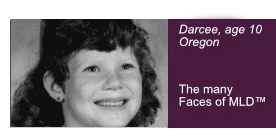|
Currently there is no cure for MLD. And to be honest, we may never be able to completly cure MLD and reverse the myelin and neuron damage that is casues, but research is underway to halt or dramatically slow MLD's progress such that it appears the disease is barely present.
If you or your loved one is pre-symptomatic or a very early symptomatic juvenile then a stem cell transplant may be an option.
Clinical trials of advanced therapies are experiments, and at various times may or may not be recurioting in your home town or country. Some clinical trials allow you to come to them to participate.
As of late-2020, MLD Foundation is working with numerous biotech and pharma compaines on MLD projects including the following:
Gene Therapy – Orchard Therapeutics, Homology Medicines, and others.
Enzyme Replacement Therapy – Takeda (formerly Shire)
HSCT, Transplant Therapy – Numerous sites including Minnesota, Pittsburgh, and Duke
There is continuing and expanding interest with several academic and institutional collaborations including GLIA.
Further, due to NDA/CDA restrictions we cannot speak about several other programs.
Bringing a new therapy or drug to market is a lengthy and detailed process - see here for details of a typical time line. Please remember it takes many years of research and trials along with millions, if not tens of millions of dollars to gain approval of a new treatment.
There are four primary lines of research into a cure for MLD. Each of these is briefly described below along with a summary of the lab(s) working on that line of research. See this link for more details of each of the therapies.
Quick Links
MLD mouse colony - establishing a research colony in the US
Brains for Brain - basic science, blood brain barrier, and collaboration on therapies
Gene Therapy [Clinical Trial recruiting underway]
Cell Replacement Therapy
Bone Marrow and Stem Cell Transplant
Umbilical, Fetal, Cord Blood, and enhanced Stem Cell Transplant[several MLD clinical trials underway]
Cell research
Enzyme Replacement Therapy [HGT-1111 cancelled]
Substrate Reduction Therapy
Establishing a MLD mouse colony for research in the United States
MLD Foundation is the sole payor establishing this colony and is actively seeking support for the ongoing maintenance and experimentation using this colony
MLD Foundation, with the generous support from the Chloe's Fight fund-raiser, have been able to fund establishing a MLD mouse colony with two varients of MLD mice in the United States. One of the two colonies will initially be used for stem cell research, and the second, with slightly different genetics will be initially used to support a substrate reduction drug program.
Basic Science & Therapies - Brains for Brain Collaborative - MLD Core
MLD Foundation is actively seeking to fund this collaboration of MLD-specific research
The Brains for Brain Collaborative of over 85 researchers and scientists from around the globe has a MLD Core research project underway consisting of 8 independent but linked MLD-specific projects.
The work ranges from four studies of the Blood Brain Barrier and how to efficiently get through it, an international MLD natural history study, and research into three therapies ... neural stem cell transplant (which could stop MLD and repair neural damage), gene therapy, and substrate reduction. More information can be found here.
Gene Therapy
Now Recruiting - Current Clinical Trial info here...
This therapy involves the manipulation of genes to deliver the missing ARSA enzyme. Dr. Francesca Fumigali, Dr. Alessandra Biffi, Dr. Luigi Naldini and their colleagues at the San Raffaele Telethon Institute for Gene Therapy in Milan, Italy are researching the efficacy and safety of hematopoietic stem cells (HSC) to deliver the therapeutic ARSA enzyme to the nervous system by the route of the blood cells.
Dr. Alessandra Biffi, M.D., when she was working at San Rafaelle Insitute in 2008, reported success with repairing the characteristics of HSCs taken from MLD-affected mice so the HSCs could express ARSA. The repaired HSCs were successfully transplanted into the central nervous system of a a mouse model. After this treatment, the effects of MLD were corrected. Using HSCs from human MLD patients, the ARSA deficiency was successfully corrected in the HSCs. The next step is giving the treated HSCs back to a MLD patient. A HSC gene therapy clinical trial has been proposed to the Italian authorities and is expected to start by the second quarter of 2009. Similar to the successful mouse therapy the affected patients HSCs are isolated, normal ARSA gene is transplanted into the isolated HSCs, then their own corrected HSCs are transplanted back into the patient. Using the patient's own HSC should reduce or eliminate the complications of graft vs. host disease and provide a long term solution to proper ARSA expression in MLD patients.
Cell Replacement Therapy
This type of therapy involves replacing diseased cells with new disease free cells. Generally this is accomplished by a transplant. The three forms being study are:
Bone Marrow or Stem Cell Transplants (BMT/SCT)
In this type of transplant a person with MLD undergoes "conditioning" to kill off their own bone marrow and then bone marrow (stem cells) from a donor, who is not affected with MLD, is injected into a person. If all goes well and the transplant is successful (engrafted), the new bone marrow cells produced contain the previous missing enzyme. The long term effects of a successful BMT/SCT are still being studied. This procedure does not reverse the damage already done by MLD and whether it stops or slows future damage is under investigation. The most success has been seen in affected siblings who are not yet showing physical signs of MLD. The The University of MN/Fairview Medical Center is one of the pioneering centers involved in Stem Cell Transplants and research. Dr. Paul Orchard is a contact there.
Umbilical Cord Blood Transplant
This type of transplant is the same as a BMT/SCT except the stem cells are obtained from umbilical cord blood. These stem cells are not as mature and do not contain the antibodies that can lead to a potentially life threatening complication of transplant called graft vs. host. Again, the most promising results have been in seen in people who are not showing significant signs of MLD (pre-symptomatic). Dr. Joanne Kurtzberg at Duke University has been pioneering this line of research.
Dr. JoAnne Kurtzberg has a clinical trial underway to test ALD-101 to accelerate platelet engraftment. Eight patients are being sought in this Phase III efficacy trial. 8 patients are being recruited in this trial which started April 2008. MLD Clinical Trial information here.
Dr. Jo Anne Kurtzberg opened a pilot trial June 2009 to evaluate in-womb fetal transplants at age 12-14 weeks for affected babies. This is a first in human trial which tests safety, with efficacy as a potential benefit. 12 patients are being recruited in cohorts of 3. MLD Clinical Trial information here.
Umbilical Cord Blood Banks
To learn more about umbilical cord blood banks click here.
Cell Research
Oligodendrocyte Research
Research is being done by Dr. Joanne Kurtzberg and Fellows at Duke University on exploring the feasibility, safety and efficacy of targeted cell therapy using umbilical cord blood derived cells called oligodendrocytes. These cells have the potential ability to repair damaged done by MLD by becoming other types of cells. (They become and replace the damaged cell). Oligodendrocytes are cultured from fresh cord blood and expanded in cultures. Animal studies are in progress to determine the best route of delivery, engraftment potential and ability of these cells to facilitate neural repair. If these studies prove safe and feasible, Phase 1 human safety trials will be planned. The hope is to some day be able to transplant these cells directly into the brain or spinal column and have them do their repairing work.
Myelin-producing cell Research
Dr. Erneston Bongarzoe and his colleagues at the San Raffaele Scientific Institute in Milan Italy are researching the transplanting and migration of myelin-producing cells in mice brains.
Dr. Gieselmann's lab in Germany is also doing similar research on MLD. This lab was the first to develop the MLD mouse model.
Creation and Study of Cell Lines
Dr. Paul Orchard, and Jakub Tolar of the University of Minnesota are researching the possibility of creating a MLD cell line from MSC and MAP C cells. This will enable a more in-depth study of MLD disease human cells and a better understanding of the disease. It will also provide a way for researchers to see how MLD human cells behave when the different therapies are applied.
Enzyme Replacement Therapy
Now Recruiting - Current Clinical Trial info here...
In this therapy, the missing enzyme (Arylsulfatase-A) is replaced by a man-made human recombinant enzyme that is injected into the MLD affected person.
Shire HGT started recruiting for their Phase I/II Clinical Trial of HGT-1110 intrathecal ERT product in January 2012. Details can be found here.
Substrate Reduction Therapy
With MLD there is not enough ARSA enzyme present to break down all of the sulfatides produced by the body. Instead of increasing the enzyme levels, which is the goal of most other MLD therapies, substrate reduction therapy focuses on reducing the amount of sulfatide produced by the body.
Dr. Maegawa from Johns Hopkins in Baltimore is working on a small molecule therapy to reduce the substrate build up. He has seen a significant reduction in build up in skin fibroblasts using a similar approach for Tay Sachs disease and is in human clinical trials for that effort. As of July 2011 he is in his second year of MLD research and has an assy in development for MLD. He plans to screen the NCGI library of elements once the assay is completed.
Zacharon Pharmaceuticals from San Diego is initiating a drug discovery program for MLD. This program is based on using assays which measure sulfatide accumulation in cultured fibroblasts as a means to discover and develop small molecule drugs for MLD. (This approach differs from other approaches which have measured enzyme activity to discover effective drugs.) As of July 2011, Zacharon has begun adapting the assays it developed for other lysosomal storage diseases so that they can be employed to discover and develop drugs for MLD.
A research study testing warfarin (Coumadin)as an inhibitor of sulfatide production was completed in 2008.To the best of our knowledge no efficacy was demonstrated. Details can be found by clicking here.
|
 Tweet this page
Tweet this page





